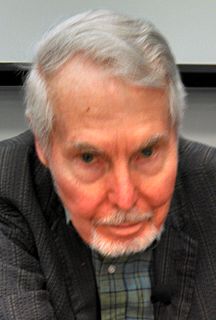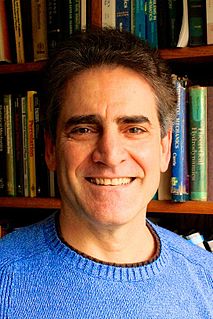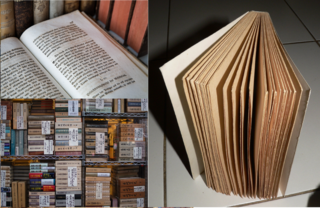
In quantum field theory, the Casimir effect and the Casimir–Polder force are physical forces arising from a quantized field. They are named after the Dutch physicist Hendrik Casimir who predicted them in 1948.

Stuart Alan Kauffman is an American medical doctor, theoretical biologist, and complex systems researcher who studies the origin of life on Earth. He was a professor at the University of Chicago, University of Pennsylvania, and University of Calgary. He is currently emeritus professor of biochemistry at the University of Pennsylvania and affiliate faculty at the Institute for Systems Biology. He has a number of awards including a MacArthur Fellowship and a Wiener Medal.

In theoretical physics, the anti-de Sitter/conformal field theory correspondence, sometimes called Maldacena duality or gauge/gravity duality, is a conjectured relationship between two kinds of physical theories. On one side are anti-de Sitter spaces (AdS) which are used in theories of quantum gravity, formulated in terms of string theory or M-theory. On the other side of the correspondence are conformal field theories (CFT) which are quantum field theories, including theories similar to the Yang–Mills theories that describe elementary particles.

Synthetic biology is an interdisciplinary branch of biology and engineering.
Extreme physical information (EPI) is a principle, first described and formulated in 1998 by B. Roy Frieden, Emeritus Professor of Optical Sciences at the University of Arizona, that states, the precipitation of scientific laws can be derived through Fisher information, taking the form of differential equations and probability distribution functions.
Strongly interacting massive particles (SIMPs) are hypothetical particles that interact strongly between themselves [looks like they scatter off each other - observation of colliding galaxies in the Abell 3827 cluster, where it seemed that dark matter lagged behind the ordinary matter] and weakly with ordinary matter, but could form the inferred dark matter despite this. However, this finding has since been discounted based on further observations and modelling of the cluster.

Mildred Dresselhaus, known as the "queen of carbon science", was the first female Institute Professor and professor emerita of physics and electrical engineering at the Massachusetts Institute of Technology. Dresselhaus won numerous awards including the Presidential Medal of Freedom, the National Medal of Science, the Enrico Fermi Award and the Vannevar Bush Award.
Copper (29Cu) has two stable isotopes, 63Cu and 65Cu, along with 27 radioisotopes. The most stable of these is 67Cu with a half-life of 61.83 hours. The least stable is 54Cu with a half-life of approximately 75 ns. Most have half-lives under a minute. Unstable copper isotopes with atomic masses below 63 tend to undergo β+ decay, while isotopes with atomic masses above 65 tend to undergo β− decay. 64Cu decays by both β+ and β−.
Naturally occurring iron (26Fe) consists of four stable isotopes: 5.845% of 54Fe (possibly radioactive with a half-life over 3.1×1022 years), 91.754% of 56Fe, 2.119% of 57Fe and 0.286% of 58Fe. There are 24 known radioactive isotopes and their half-lives are shown below. See Brookhaven National Laboratory Interactive Table of Nuclides for a more accurate reading.

John David Jackson was a Canadian–American physics professor emeritus at the University of California, Berkeley and a faculty senior scientist emeritus at Lawrence Berkeley National Laboratory. A theoretical physicist, he was a member of the National Academy of Sciences, and is well known for numerous publications and summer-school lectures in nuclear and particle physics, as well as his widely-used graduate text on classical electrodynamics. The book is notorious for the difficulty of its problems, and its tendency to treat non-obvious conclusions as self-evident. Jackson's high standards and admonitory vocabulary are the subject of an amusing memorial volume by his son Ian Jackson.

Molecular motors are biological molecular machines that are the essential agents of movement in living organisms. In general terms, a motor is a device that consumes energy in one form and converts it into motion or mechanical work; for example, many protein-based molecular motors harness the chemical free energy released by the hydrolysis of ATP in order to perform mechanical work. In terms of energetic efficiency, this type of motor can be superior to currently available man-made motors. One important difference between molecular motors and macroscopic motors is that molecular motors operate in the thermal bath, an environment in which the fluctuations due to thermal noise are significant.
Thermosynthesis is a theoretical mechanism proposed by Anthonie Muller for biological use of the free energy in a temperature gradient to drive energetically uphill anabolic reactions. It makes use of this thermal gradient, or the dissipative structure of convection in this gradient, to drive a microscopic heat engine that performs condensation reactions. Thus negative entropy is generated. The components of the biological thermosynthesis machinery concern progenitors of today's ATP synthase, which functions according to the binding change mechanism, driven by chemiosmosis. Resembling primitive free energy generating physico-chemical processes based on temperature-dependent adsorption to inorganic materials such as clay, this simple type of energy conversion is proposed to have sustained the origin of life, including the emergence of the RNA World. For this RNA World it gives a model that describes the stepwise acquisition of the set of transfer RNAs that sustains the Genetic code. The phylogenetic tree of extant transfer RNAs is consistent with the idea.

Nathaniel David Mermin is a solid-state physicist at Cornell University best known for the eponymous Mermin–Wagner theorem, his application of the term "boojum" to superfluidity, his textbook with Neil Ashcroft on solid-state physics, and for contributions to the foundations of quantum mechanics and quantum information science.
Quantum biology refers to applications of quantum mechanics and theoretical chemistry to biological objects and problems. Many biological processes involve the conversion of energy into forms that are usable for chemical transformations, and are quantum mechanical in nature. Such processes involve chemical reactions, light absorption, formation of excited electronic states, transfer of excitation energy, and the transfer of electrons and protons in chemical processes, such as photosynthesis, olfaction and cellular respiration. Quantum biology may use computations to model biological interactions in light of quantum mechanical effects. Quantum biology is concerned with the influence of non-trivial quantum phenomena, which can be explained by reducing the biological process to fundamental physics, although these effects are difficult to study and can be speculative. The field of study does not imply any new physical principles are needed, since the quantum mechanical study of reaction rates and energy transfer is well established. To date, there are no observations of quantum biology that imply quantum effects are observable in macroscopic organisms, or that are crucial for the existence of life.

Complex systems biology (CSB) is a branch or subfield of mathematical and theoretical biology concerned with complexity of both structure and function in biological organisms, as well as the emergence and evolution of organisms and species, with emphasis being placed on the complex interactions of, and within, bionetworks, and on the fundamental relations and relational patterns that are essential to life. CSB is thus a field of theoretical sciences aimed at discovering and modeling the relational patterns essential to life that has only a partial overlap with complex systems theory, and also with the systems approach to biology called systems biology; this is because the latter is restricted primarily to simplified models of biological organization and organisms, as well as to only a general consideration of philosophical or semantic questions related to complexity in biology. Moreover, a wide range of abstract theoretical complex systems are studied as a field of applied mathematics, with or without relevance to biology, chemistry or physics.

Gian Francesco Giudice is an Italian theoretical physicist working at CERN in particle physics and cosmology.

A time crystal or space-time crystal is a structure that repeats in time, as well as in space. Normal three-dimensional crystals have a repeating pattern in space, but remain unchanged as time passes. Time crystals repeat themselves in time as well, leading the crystal to change from moment to moment. A time crystal never reaches thermal equilibrium, as it is a type of non-equilibrium matter, a form of matter proposed in 2012, and first observed in 2017. This state of matter cannot be isolated from its environment—it is an open system in non-equilibrium.

Salvatore Torquato is an American theoretical scientist born in Falerna, Italy. His research work has impacted a variety of fields, including physics, chemistry, applied and pure mathematics, materials science, engineering, and biological physics. He is the Lewis Bernard Professor of Natural Sciences in the Department of Chemistry and Princeton Institute for the Science and Technology of Materials at Princeton University. He has been a Senior Faculty Fellow in the Princeton Center for Theoretical Science, an enterprise dedicated to exploring frontiers across the theoretical natural sciences. He is also an Associated Faculty Member in three departments or programs at Princeton University: Physics, Program in Applied and Computational Mathematics, and Mechanical & Aerospace Engineering. On multiple occasions, he was a Member of the School of Mathematics as well as the School of Natural Sciences at the Institute for Advanced Study, Princeton, New Jersey.
Daniel E. Lieberman is a paleoanthropologist at Harvard University, where he is the Edwin M Lerner II Professor of Biological Sciences, and chair of the Department of Human Evolutionary Biology. He is best known for his research on the evolution of the human head and the evolution of the human body.
Badanaval Venkatasubba Sreekantan is an Indian high-energy astrophysicist and a former associate of Homi J. Bhabha at the Tata Institute of Fundamental Research (TIFR). He is also a Dr. S. Radhakrishnan Visiting Professor at the National Institute of Advanced Studies, Bangalore. Known for his studies in the fields of cosmic rays, elementary particles, and high-energy X-ray astronomics, Sreekantan is an elected fellow of all the three major Indian science academies namely, the Indian Academy of Sciences, the Indian National Science Academy and the National Academy of Sciences, India as well as the Maharashtra Academy of Sciences. He was also an associate of Bruno Rossi at Massachusetts Institute of Technology. The Government of India awarded him the Padma Bhushan, India's third highest civilian honour, in 1988.















